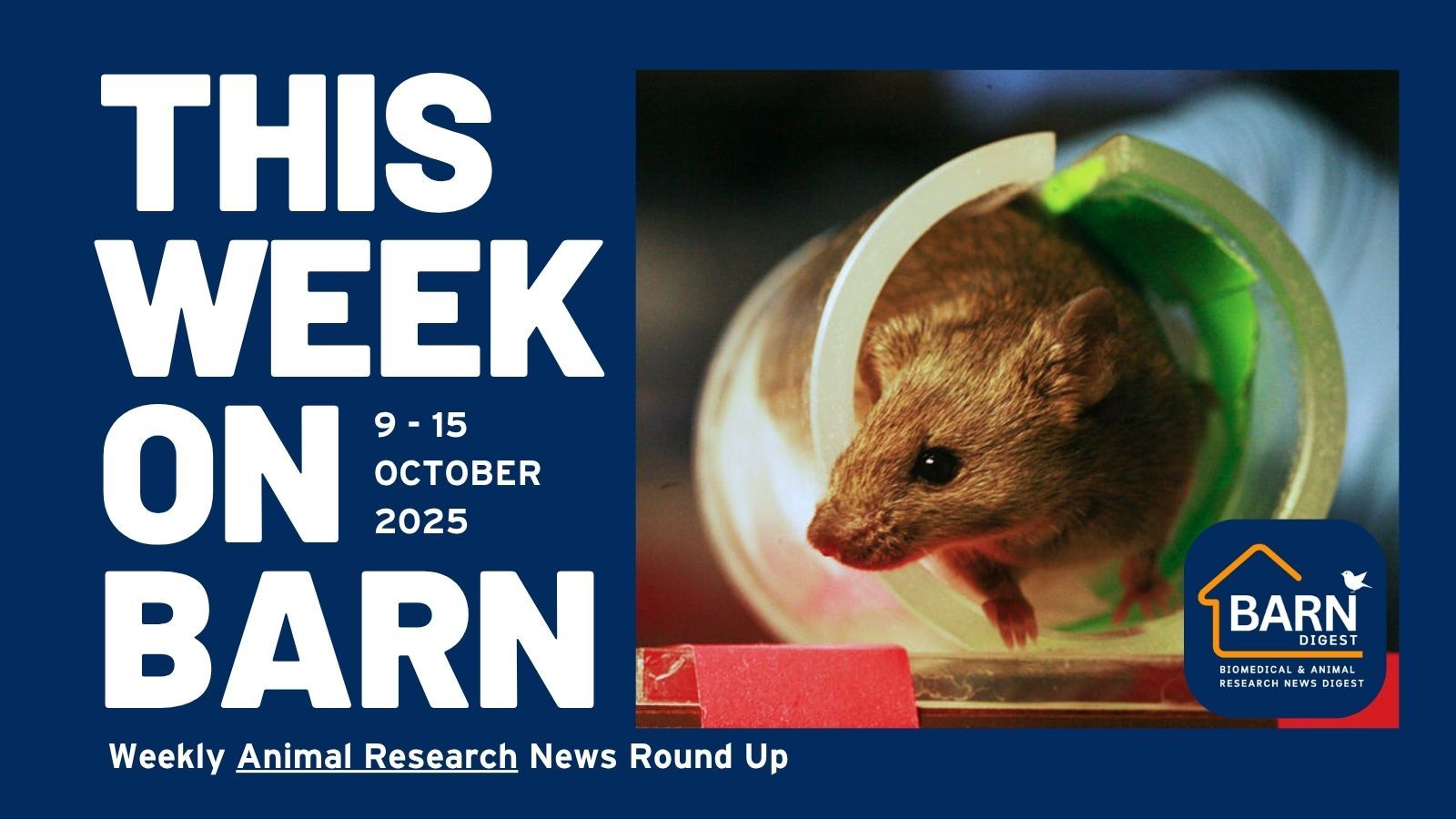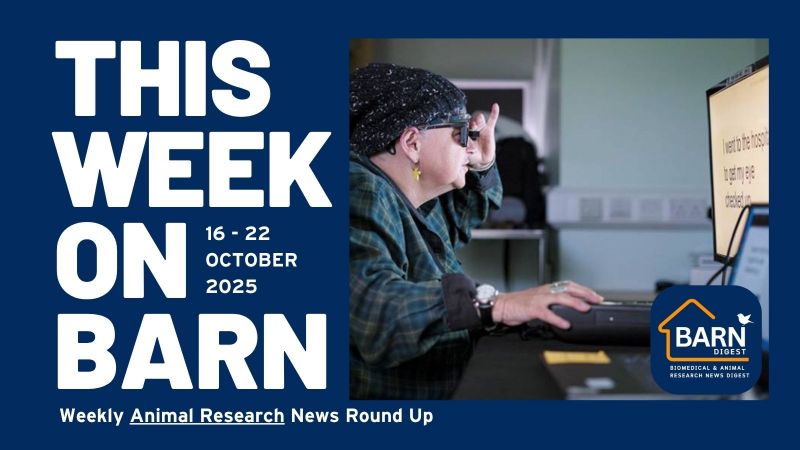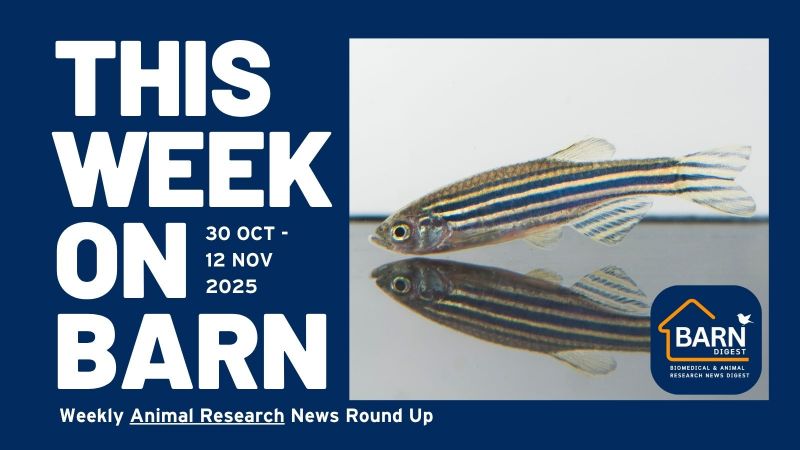
The Biomedical Animal Research News (BARN) Digest collates animal research news from UAR’s 150+ member organisations into one, easy to access, feed. These animal research related stories include topics such as: medical studies and advancements; animal welfare and 3Rs news; funding, regulatory, and policy news; and conservation and environmental research that involves animal testing.
Each week, we pick the most interesting, groundbreaking, and important news to feature in a weekly news roundup. In this round up we feature news stories from 9-15 October 2025.
View BARN to see daily news updates from UAR members.
DISCOVERY / BASIC RESEARCH
Study reveals genetic link between childhood brain disorder and Parkinson's disease in adults
KINGS COLLEGE LONDON, UCL | MICE, NEMATODES, HUMANS
"The study, published in the Annals of Neurology, looked at a gene called EPG5. Errors in this gene are already known to cause Vici syndrome – a rare and severe inherited neurodevelopmental condition that presents early in life and affects multiple organ systems.
Now researchers at UCL, King’s College London, the University of Cologne and the Max Planck Institute for Biology of Ageing have found that errors in the same gene are linked to changes in nerve cells that lead to more common age-related conditions like Parkinson’s disease and dementia.
In the largest study of its kind to date, the team of scientists analysed clinical and genetic data from 211 individuals from across the world with rare errors in EPG5. They found that the effects of these genetic errors are broader and more variable than previously known – while some individuals had life-limiting forms of Vici syndrome identified before or shortly after birth, others showed much milder symptoms, including delay in movement, speech, and learning. The researchers also discovered that some of the patients included in the study went on to develop a breakdown of nerve cells in adolescence or early adulthood that led to Parkinson's disease and dementia.
To explore the biology underpinning their findings, the researchers used patient-derived cells and model organisms, including mice and the tiny roundworm C. elegans, and introduced errors into EPG5. These experiments showed that genetic errors in the gene disrupt the cell’s ability to clear damaged components from the cell, leading to the build-up of proteins closely associated with Parkinson’s disease."
https://onlinelibrary.wiley.com/doi/10.1002/ana.78013
Nanoparticles reverse Alzheimer’s pathology in mice
UCL | MICE
"Instead of targeting neurons directly, the therapy restores the proper function of the blood-brain barrier, the vascular gatekeeper that regulates the brain's environment. By repairing this critical interface, the researchers achieved a reversal of Alzheimer's pathology in animals.
The team demonstrated that targeting a specific mechanism enables undesirable "waste proteins" produced in the brain to pass through this barrier and be eliminated in the blood flow. In Alzheimer's disease, the main "waste" protein is amyloid beta (amyloid-β, or Aβ), whose accumulation impairs the normal functioning of the neurons.
Researchers used mice that are genetically programmed to produce larger amounts of Aβ protein and develop a significant cognitive decline mimicking Alzheimer's pathology. They administered only three doses of the supramolecular drugs and afterward regularly monitored the evolution of the disease.
The most striking data were the therapeutic effects. Researchers conducted various experiments to analyse the behaviour of the animals and measure their memory decline over several months, covering all stages of the disease.
In one of the experiments, they treated a 12-month-old mouse (roughly equivalent to a 60-year-old human) with the nanoparticles and found that six months later it had recovered the behaviour of a healthy mouse"
https://www.ucl.ac.uk/news/2025/oct/nanoparticles-reverse-alzheimers-pathology-mice
https://www.nature.com/articles/s41392-025-02426-1
New breakthrough shows promise for protecting people against kidney damage in type 1 diabetes
UNIVERSITY OF BRISTOL | MICE
"The study, driven by first author, Dr Aldara Martin Alonso and led by Dr Rebecca Foster, Associate Professor of Microvascular Medicine at Bristol Medical School: Translational Health Sciences, explored the potential of delivering a protein called VEGF-C directly into kidney cells.
Previous studies have shown VEGFC could protect against kidney disease as it helps keeps blood vessels in the kidney filter healthy, repairing early signs of diabetes-related kidney damage.
To test whether this new approach could be used to treat or slow down kidney disease, the team used a harmless virus to deliver VEGF-C directly into the kidney cells of diabetic mice.
Their results showed that this approach not only helped the kidneys work better, but also protected a key part of the kidney filter that normally helps prevent damage. It led to a 64% reduction in albuminuria — the presence of a protein called albumin in the urine, which is a common sign of kidney disease. Importantly, this reduction is more than twice the reduction recommended by the American Diabetes Association to slow the progression of chronic kidney disease."
https://www.bristol.ac.uk/news/2025/october/type1-diabetes.html
https://www.sciencedirect.com/science/article/pii/S1525001625008226?via%3Dihub
CLINICAL TRIALS
Positive results from early trial of drug that could protect brain cells
PARKINSONS UK | MICE, HUMANS
The role of HER-096 in Parkinson's was first determined in mice.
"HER-096, a potential new Parkinson's treatment, has shown promising phase 1 trial results, proving it’s safe, well-tolerated, and effective in reaching the brain in people with Parkinson's. This is a crucial step towards a drug that could slow, stop, or even repair Parkinson's damage."
https://www.parkinsons.org.uk/news/positive-results-early-trial-drug-could-protect-brain-cells
Mouse studies:
https://pubmed.ncbi.nlm.nih.gov/21943517/
https://www.sciencedirect.com/science/article/pii/S2451945623004208#cebib0010
FUNDING
New way to treat high blood pressure on the horizon thanks to funding award
UNIVERSITY OF ABERDEEN | MICE
"The £125k award from the ‘Proof of Concept’ scheme will see the University-led drug development pre-spinout group DIOKA Therapeutics test whether their revolutionary new idea will work beyond the cellular level that has already proven more successful than they could have imagined.
This next step of the project will involve testing whether these medications are effective to reduce blood pressure in animal models, the optimum dose and several other factors that need to be considered before moving to human trials."
https://www.abdn.ac.uk/news/24732/
ENVIRONMENT
First evidence in the UK of breeding aegypti mosquito – the main spreader of dengue, chikungunya and Zika
UNIVERSITY OF LIVERPOOL | MOSQUITOES
"Scientists have found eggs of the Aedes aegypti mosquito in the UK for the first time – a mosquito that spreads many tropical diseases.
The eggs were recently discovered in a trap at a freight depot near Heathrow airport and confirmed by DNA testing to be Ae aegypti. The discovery, led by the UK Health Security Agency, also reported further findings of Aedes albopictus, the “Asian tiger” mosquito, at a site in Kent in summer 2024. Both species are invasive and thrive in warm, humid conditions.
These Aedes mosquitoes matter because they can spread viruses such as dengue, chikungunya and Zika. Outbreaks of these diseases, once confined to the tropics, are now appearing in Europe."
Clam shells sound warning of Atlantic ‘tipping point’
UNIVERSITY OF EXETER | CLAMS
"A study of clam shells suggests Atlantic Ocean currents may be approaching a “tipping point”.
Scientists studied records of quahog clams (which can live for over 500 years) and dog cockles – because shell layers provide an annual record of ocean conditions.
They studied these natural archives to understand long-term patterns in Atlantic Ocean currents such as the Atlantic Meridional Overturning Circulation (AMOC) and the subpolar gyre (SPG).
The new study, led by the University of Exeter, finds evidence of “stability loss” which suggests the region is “moving towards a tipping point”."
NEW APPROACH METHODOLOGIES (NAMS)/REPLACING ANIMALS IN RESEARCH
New lab-grown human embryo model produces blood cells
UNIVERSITY OF CAMBRIDGE | HUMAN EMBRYO MODEL
"Researchers have found a new way to produce human blood cells in the lab that mimics the process in natural embryos. Their discovery holds potential to simulate blood disorders like leukaemia, and to produce long-lasting blood stem cells for transplants.
Although other methods exist for generating human blood stem cells in the laboratory, these require a cocktail of extra proteins to support the stem cells’ growth and development. The new method mimics the natural developmental process, based on a self-organising human embryo-like model, where the cells’ intrinsic support environment drives the formation of blood cells and beating heart cells within the same system."
https://www.cam.ac.uk/research/news/new-lab-grown-human-embryo-model-produces-blood-cells
Visit BARN for daily news updates
Last edited: 14 October 2025 12:04




